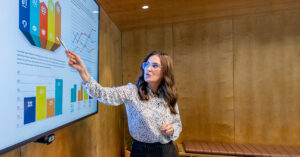Are you more stressed out today than you were a year ago? Unfortunately, so are your healthcare consumers. For marketers, stressed consumers mean scattered journeys and meeting them where they are. But how? For our June Campfire webinar, we invited Hinge Health and Stericycle marketing leaders to share how they are navigating the new busy, stressed consumer dynamic to drive better marketing performance.
Americans have hit the stress ceiling, impacting marketers’ ability to engage consumers.
The American Psychological Association reports that Americans have been experiencing the highest stress levels since the organization began fielding its “Stress in America” survey in 2007.
Most likely, you’re nodding your head and thinking, “Yep, me too.”
Your healthcare consumers are stressed too. And that has significant implications for marketers and healthcare leaders.
For our June 2022 Campfire webinar, we invited panelists Sarah Bennight from Stericycle and Maria Kellner from Hinge Health to share how they engage their busy, stressed patient, clinical, and provider audiences.
Get to the Point
During the webinar, Sarah shared that patients are delaying care because they’re too busy attending to work and life demands. The same goes for B2B consumer audiences. They work long hours to compensate for understaffed departments and increased work demands. That means marketing messages need to cut to the chase. Be brief, direct, and precise with messages, value propositions, and calls to action. Otherwise, your consumers may tune out and move on to the next thing.
On-Demand Content
Sarah also shared that B2B marketing trends are increasing in on-demand content versus real-time content, such as live webinars. Why is that? It may be due to B2B audiences managing additional work responsibilities as many departments are short-staffed. Sarah terms this strategy “After Hours Content,” meaning audiences consume information and resources outside traditional work hours. Consider upping your on-demand webinars to your portfolio, blog post articles, and podcast content.
Less Flash, More Substance
Maria noted that consumers are turning away from advertising that feels too flashy—a red flag to consumers that they are being “marketed to.” Instead, the marketing campaigns that are getting more engagement are campaigns that feel down to earth and resonate with the stressful realities that many consumers are facing these days.
Scattered Consumer Journeys
We’ve written about patient and consumer journeys extensively at Hailey Sault. Sarah shared that today’s consumer journey looks more scattered: people are zig-zagging, pausing, or delaying purchasing decisions. Instead of expecting linear consumer journeys, plan your marketing campaigns around longer timeframe purchase decisions. In addition, create content that encourages consumers to restart their journeys when they get derailed by life and work demands.
Make Healthcare Easier
Sarah noted that consumers are basing healthcare experiences on brands like Amazon, which have mastered the art of making purchases easy. What can marketers do? Maria encouraged marketers to meet their consumer audiences where they are, such as by providing more at-home healthcare delivery solutions. Also, collaborate with IT to simplify online user experiences, study your marketing analytics to identify stuck points on consumers’ purchase paths, and reduce the friction with online purchases and conversion points.
In-Person Events Are Making a Comeback
Sarah noted a recent HITMC survey that shows in-person conferences are now considered the most effective marketing tactic among B2B buyers and marketers. We wrote about our experience at HMPS22 recently and validate this insight. After two years of working from home, it’s thrilling to be back in the room with people. Zoom is great, but it doesn’t match in-person conversations.
Test, Learn, Adapt (and Repeat)
Maria noted that her fast-growing startup company embodies the philosophy of moving fast, trying new things, and applying those learnings. This formula has two keys to success: access to good-quality data to make informed decisions and leadership that embraces this philosophy. Sarah’s company, Stericycle, founded in 1989, is considered the leader in its category. You’d think Stericycle would play it safe as such a big company. Yet Sarah shared that the organization’s leadership embraces the belief that “We have to do it better.” That belief drives a philosophy of trying new things, learning and adapting. Sarah’s advice to her team is advice we can all benefit from: “Remember, it’s okay to fail.”
Take Care of Yourself
Your consumers are stressed, and you’re probably feeling your version of stress these days, too. So we ended our discussion by sharing what we’re doing to de-stress. Maria’s advice is not to forget you’re a person outside your job: maintain hobbies and stress-relieving activities. Sarah’s advice is to take time each day to find joy and encourage your team members to take time off—and BE off.
As healthcare marketers, we might not be the ones directly impacting patient care, but knowing our organizations are making a difference helps keep us aligned with purpose. Maria shared that she often views her company’s patient testimonials to give her a shot in the arm when the stress mounts.
I advise avoiding looking at your phone for as long as possible each morning. Get centered, get grounded, remind yourself of what’s most important to do and get done, and then check your phone. The day’s fires will still be there for you to put out: but at least you’ll be centered and remember what matters most.



